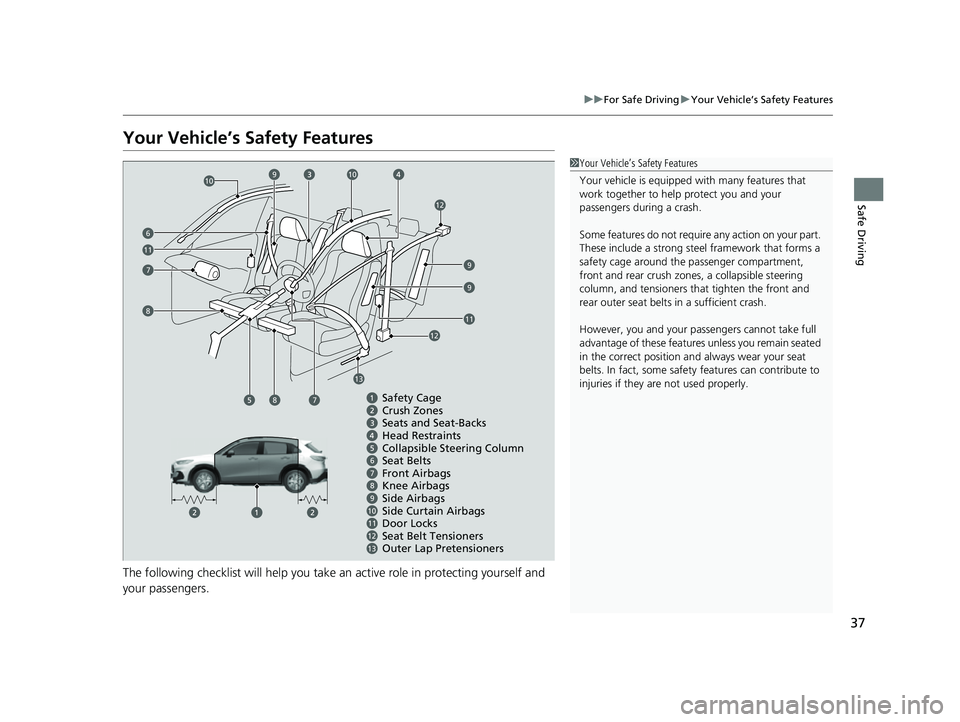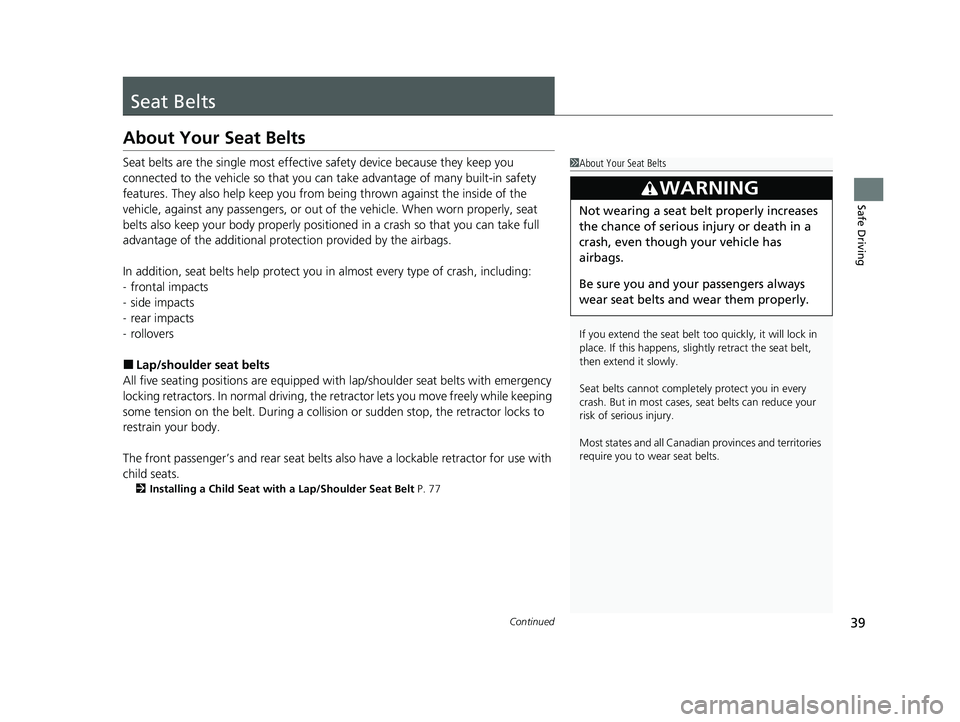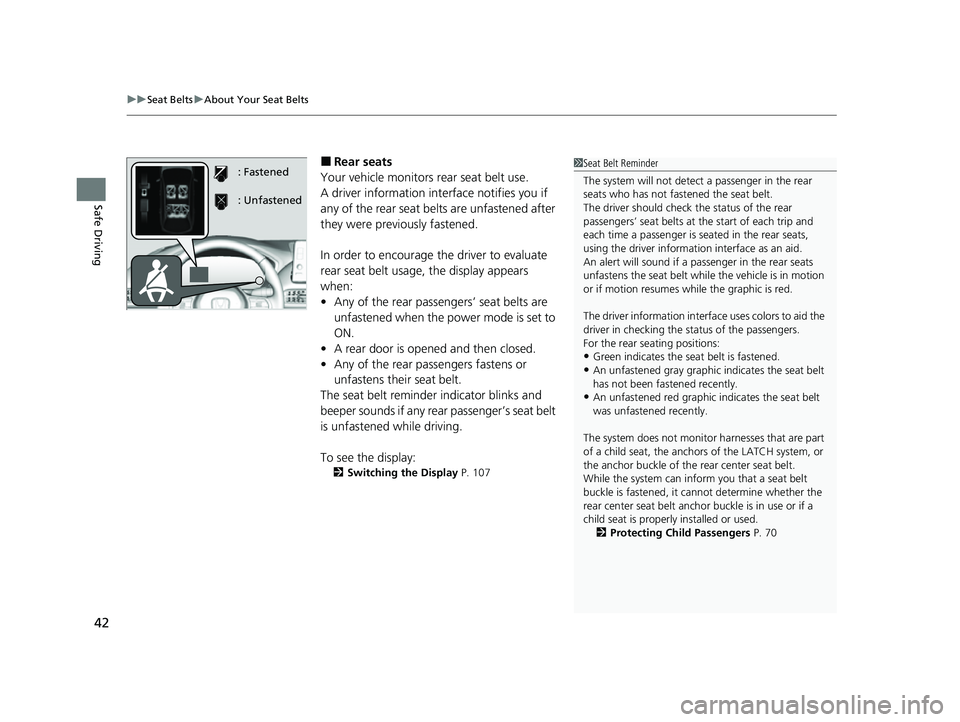2023 HONDA HRV seats
[x] Cancel search: seatsPage 8 of 664

Contents
This owner’s manual should be considered a permanent part of the
vehicle and should remain with the vehicle when it is sold.
The Navigation Manual is available online at honda.ca. If you are
the first registered owner of your vehicle, you may request a
complimentary printed copy of the Navigation Manual within
the first six months of vehicle purchase. Please request a copy
from your Honda dealer.
This owner’s manual covers all models of your vehicle. You may find
descriptions of equipment and features that are not on your
particular model.
Images throughout this owner’s ma nual (including the front cover)
represent features and equipment that are available on some, but
not all, models. Your particular mo del may not have some of these
features.
This owner’s manual is for vehicles sold in the United States and
Canada.
The information and specifications in cluded in this publication were
in effect at the time of approval for printing. Honda Motor Co., Ltd.
reserves the right, however, to discontinue or change specifications
or design at any time without notice and without incurring any
obligation.2 Safe Driving P. 33
For Safe Driving P. 34 Seat Belts P. 39 Airbags P. 50
2Instrument Panel P. 85
Indicators P. 86 Gauges and Driver Information Interface P. 104
2Controls P. 133
Clock P. 134 Locking and Unlocking the Doors P. 136
Moonroof* P. 162
Seats P. 180 Interior Convenience Items P. 189
2 Features P. 211
Audio System P. 212 Audio System Basic Operation P. 219, 244
Customized Features P. 337, 345 Bluetooth® HandsFreeLink ® P. 369, 389
2 Driving P. 409
Before Driving P. 410 Towing a Trailer P. 415
Braking P. 528 Parking Your Vehicle P. 537
2Maintenance P. 551
Before Performing Maintenance P. 552 Maintenance MinderTM P. 555
Checking and Maintaining Wiper Blades P. 577
Climate Control System Maintenance P. 595
2Handling the Unexpected P. 603
Tools P. 604If a Tire Goes Flat P. 605
Overheating P. 620 Indicator, Coming On/Blinking P. 622 Fuses P. 628
If You Cannot Open the Ta ilgate P. 636 Refueling P. 637
2Information P. 639
Specifications P. 640 Identification Numbers P. 642
Emissions Testing P. 645 Warranty Coverages P. 647
23 HR-V-313V06000_01.book 6 ページ 2022年4月4日 月曜日 午前10時49分
Page 13 of 664

11
Quick Reference Guide
❚Seat Belt (Installing a Child Seat) (P77)
❚Sun Visors
❚Vanity Mirrors
❚Map Lights (P190)
❚Moonroof Switch* (P162)
❚Seat Belts (P39)
❚Front Seat (P180)
❚Front Side Airbags (P61)
❚USB Ports (P213)
❚Cargo Area Lights (P191)
❚Seat Belt with Detachable Anchor (P47)
❚Accessory Power Socket (P196)
❚Grab Handle
❚Coat Hook (P194)
❚Seat Belt to Secure a Child Seat (P79)
❚LATCH to Secure a Child Seat (P75)
❚Rear Seats (P183)
❚Rear Side Airbags (P61)
❚Map Lights (P190)
❚Side Curtain Airbags (P64)
* Not available on all models
23 HR-V-313V06000_01.book 11 ページ 2022年4月4日 月曜日 午前10時49分
Page 16 of 664

14
Quick Reference Guide
Safe Driving (P 33)
Airbags (P50)
●Your vehicle is fitted with airbags to help protect you and
your passengers during a moderate-to-severe collision.
Child Safety (P70)
●All children 12 and younger should be seated in the rear seat.●Smaller children should be properly restrained in a forward-facing child seat.●Infants must be properly restrained in a rear-facing child seat.
Exhaust Gas Hazard (P83)
●Your vehicle emits dangerous exhaust gases that contain
carbon monoxide. Do not run the engine in confined spaces
where carbon monoxide gas can accumulate.
Before Driving Checklist (P38)
●Before driving, check that the front seats, head
restraints, steering wheel, and mirrors have been
properly adjusted.
Seat Belts (P39)
●Fasten your seat belt and sit upright well
back in the seat.
●Check that your passengers are wearing
their seat belts correctly.
Fasten your lap belt as
low as possible.
23 HR-V-313V06000_01.book 14 ページ 2022年4月4日 月曜日 午前10時49分
Page 39 of 664

37
uuFor Safe Driving uYour Vehicle’s Safety Features
Safe Driving
Your Vehicle’s Safety Features
The following checklist will help you take an active role in protecting yourself and
your passengers.
1Your Vehicle’s Safety Features
Your vehicle is equipped wi th many features that
work together to help protect you and your
passengers during a crash.
Some features do not require any action on your part.
These include a strong steel framework that forms a
safety cage around the passenger compartment,
front and rear crush zone s, a collapsible steering
column, and tensioners th at tighten the front and
rear outer seat belts in a sufficient crash.
However, you and your passe ngers cannot take full
advantage of these features unless you remain seated
in the correct position and always wear your seat
belts. In fact, some safety features can contribute to
injuries if they are not used properly.
67891011
Crush Zones
Seats and Seat-Backs
Head Restraints
Collapsible Steering Column
Seat Belts
Front Airbags
Side Curtain Airbags
Seat Belt Tensioners Knee Airbags
Door Locks Safety Cage
79
9
8
10
6
11
10
12
13
9
11
12
8
Side Airbags
1213Outer Lap Pretensioners
7
23 HR-V-313V06000_01.book 37 ページ 2022年4月4日 月曜日 午前10時49分
Page 40 of 664

38
uuFor Safe Driving uSafety Checklist
Safe Driving
Safety Checklist
For the safety of you and your passenge rs, make a habit of checking these items
each time before you drive.
• After everyone has entered the vehicle, be sure all doors and the tailgate are
closed and locked. Locking the doors and the tailgate helps prevent an occupant
from being ejected and an outsider from unexpectedly opening a door or the
tailgate.
2 Locking/Unlocking the Doors from the Inside P. 149
•Adjust your seat to a position suitable for driving. Be sure the front seats are
adjusted as far to the rear as possible while allowing the driver to control the
vehicle. Sitting too close to a front airbag can result in serious or fatal injury in a
crash.
2 Seats P. 180
•Adjust head restraints to the proper position. Head restraints are most effective
when the center of the head restraint alig ns with the center of your head. Taller
persons should adjust their head restraint to the highest position.
2 Adjusting the front head restraint positions P. 186
•Always wear your seat belt, and make sure you wear it properly. Confirm that any
passengers are properly belted as well.
2 Fastening a Seat Belt P. 44
•Protect children by using seat belts or child seats according to a child’s age,
height, and weight.
2 Child Safety P. 70
1Safety Checklist
If the door and/or tailga te open message appears on
the driver information inte rface, a door and/or the
tailgate is not completely closed. Close all doors and
the tailgate tightly unti l the message disappears.
23 HR-V-313V06000_01.book 38 ページ 2022年4月4日 月曜日 午前10時49分
Page 41 of 664

39Continued
Safe Driving
Seat Belts
About Your Seat Belts
Seat belts are the single most effective safety device because they keep you
connected to the vehicle so that you can take advantage of many built-in safety
features. They also help keep you from be ing thrown against the inside of the
vehicle, against any passengers, or out of the vehicle. When worn properly, seat
belts also keep your body properly positioned in a crash so that you can take full
advantage of the additional protection provided by the airbags.
In addition, seat belts help protect you in almost every type of crash, including:
- frontal impacts
- side impacts
- rear impacts
- rollovers
■Lap/shoulder seat belts
All five seating positions are equipped with lap/shoulder seat belts with emergency
locking retractors. In normal driving, the re tractor lets you move freely while keeping
some tension on the belt. During a collision or sudden stop, the retractor locks to
restrain your body.
The front passenger’s and rear seat belts al so have a lockable retractor for use with
child seats.
2 Installing a Child Seat with a Lap/Shoulder Seat Belt P. 77
1About Your Seat Belts
If you extend the seat belt t oo quickly, it will lock in
place. If this happens, sli ghtly retract the seat belt,
then extend it slowly.
Seat belts cannot complete ly protect you in every
crash. But in most cases, seat belts can reduce your
risk of serious injury.
Most states and all Canadian provinces and territories
require you to w ear seat belts.
3WARNING
Not wearing a seat belt properly increases
the chance of serious injury or death in a
crash, even though your vehicle has
airbags.
Be sure you and your passengers always
wear seat belts and wear them properly.
23 HR-V-313V06000_01.book 39 ページ 2022年4月4日 月曜日 午前10時49分
Page 43 of 664

Continued41
uuSeat Belts uAbout Your Seat Belts
Safe Driving■Front seats
The seat belt system includes an indicator on
the instrument panel to remind the driver or a
front passenger or both to fasten their seat
belts.
If you set the power mode to ON and a seat
belt is not fastened, a beeper will sound, and
the indicator will blink. After a few seconds,
the beeper will stop and the indicator will
come on and remain illuminated until the seat
belt is fastened.
The beeper will periodically sound and the
indicator will blink while the vehicle is moving
until the seat belt is fastened.
■Seat Belt Reminder1 Seat Belt Reminder
The indicator will also co me on if a front passenger
does not fasten their seat be lt within six seconds after
the power mode is set to ON.
When no one is sitting in th e front passenger’s seat,
the indicator will not come on and the beeper will not
sound.
The indicator also may not come on, and the beeper
may not sound when the occupant is not heavy
enough to trigger the weight sensor. Such occupants
(e.g., infants and smaller children) should be moved
to the rear seat as a deploying front airbag likely will
injure or kill them. 2 Protecting Child Passengers P. 70
The driver information interface uses colors to aid the
driver in checking the st atus of the passengers.
For the front seating positions:
•Green indicates the seat belt is fastened.
•An unfastened gray graphic indicates the seat belt
is not fastened, and an occupant has not been
detected.
•An unfastened red graphic i ndicates the seat belt is
unfastened, and an occupa nt has been detected.
: Fastened
: Unfastened
23 HR-V-313V06000_01.book 41 ページ 2022年4月4日 月曜日 午前10時49分
Page 44 of 664

uuSeat Belts uAbout Your Seat Belts
42
Safe Driving
■Rear seats
Your vehicle monitors rear seat belt use.
A driver information inte rface notifies you if
any of the rear seat belts are unfastened after
they were previously fastened.
In order to encourage the driver to evaluate
rear seat belt usage, the display appears
when:
• Any of the rear passengers’ seat belts are
unfastened when the power mode is set to
ON.
• A rear door is opened and then closed.
• Any of the rear passengers fastens or
unfastens their seat belt.
The seat belt reminder indicator blinks and
beeper sounds if any rear passenger’s seat belt
is unfastened while driving.
To see the display:
2 Switching the Display P. 107
: Fastened
: Unfastened1Seat Belt Reminder
The system will not detect a passenger in the rear
seats who has not fastened the seat belt.
The driver should check the status of the rear
passengers’ seat belts at th e start of each trip and
each time a passenger is seated in the rear seats,
using the driver information interface as an aid.
An alert will sound if a pa ssenger in the rear seats
unfastens the seat belt whil e the vehicle is in motion
or if motion resumes wh ile the graphic is red.
The driver information interface uses colors to aid the
driver in checking the st atus of the passengers.
For the rear seating positions:
•Green indicates the seat belt is fastened.
•An unfastened gray graphic indicates the seat belt
has not been fastened recently.
•An unfastened red graphic indicates the seat belt
was unfastened recently.
The system does not monito r harnesses that are part
of a child seat, the anchors of the LATCH system, or
the anchor buckle of the rear center seat belt.
While the system can inform you that a seat belt
buckle is fastened, it ca nnot determine whether the
rear center seat belt anchor buckle is in use or if a
child seat is properly installed or used.
2 Protecting Child Passengers P. 70
23 HR-V-313V06000_01.book 42 ページ 2022年4月4日 月曜日 午前10時49分